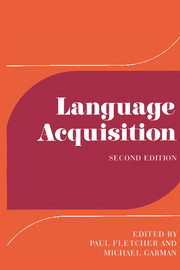Book contents
- Frontmatter
- Contents
- Contributors
- Preface
- Part I Contexts and determinants
- Part II The development of linguistic systems: phonology
- Part III The development of linguistic systems: grammar
- Part IV Later language development
- Introduction
- 21 Some fundamental aspects of language development after age 5
- 22 The development of reading: the acquisition of a cognitive skill
- 23 Language acquisition and writing
- Notes to chapters
- Bibliography and citation index
- General index
- Titles in the series
23 - Language acquisition and writing
Published online by Cambridge University Press: 05 June 2012
- Frontmatter
- Contents
- Contributors
- Preface
- Part I Contexts and determinants
- Part II The development of linguistic systems: phonology
- Part III The development of linguistic systems: grammar
- Part IV Later language development
- Introduction
- 21 Some fundamental aspects of language development after age 5
- 22 The development of reading: the acquisition of a cognitive skill
- 23 Language acquisition and writing
- Notes to chapters
- Bibliography and citation index
- General index
- Titles in the series
Summary
Introduction
It is rather unusual for written language to feature in general studies of children's language acquisition. This is perhaps partly because linguists have repeatedly emphasized the primacy of the oral language; also because, as writing is explicitly taught, its development is felt to be more susceptible than speech to the directive intervention of adults. Furthermore, it is not always possible to be sure of the precise status of children's written texts – a piece of writing might, for example, be a child's own first draft, or an unaided revision, or a final version incorporating a teacher's alterations. Nevertheless, there are at least two sound reasons for viewing the acquisition of written language as an integral part of language development. First, in societies with a reasonably long tradition of literacy, the ability to write is an important aspect of linguistic competence: it seems fair to say that someone who can speak but cannot write has not fully acquired the language. Secondly, the grammatical structures of written language are characteristically different from those of speech, since writing is not simply a transcription of oral language. So, in learning to write, children have to learn to use constructions other than the ones they regularly use in their spontaneous speech. To understand the full extent and complexity of the language acquisition process, therefore, it is necessary to be aware of the development of these more literary constructions.
- Type
- Chapter
- Information
- Language AcquisitionStudies in First Language Development, pp. 494 - 518Publisher: Cambridge University PressPrint publication year: 1986
- 19
- Cited by



